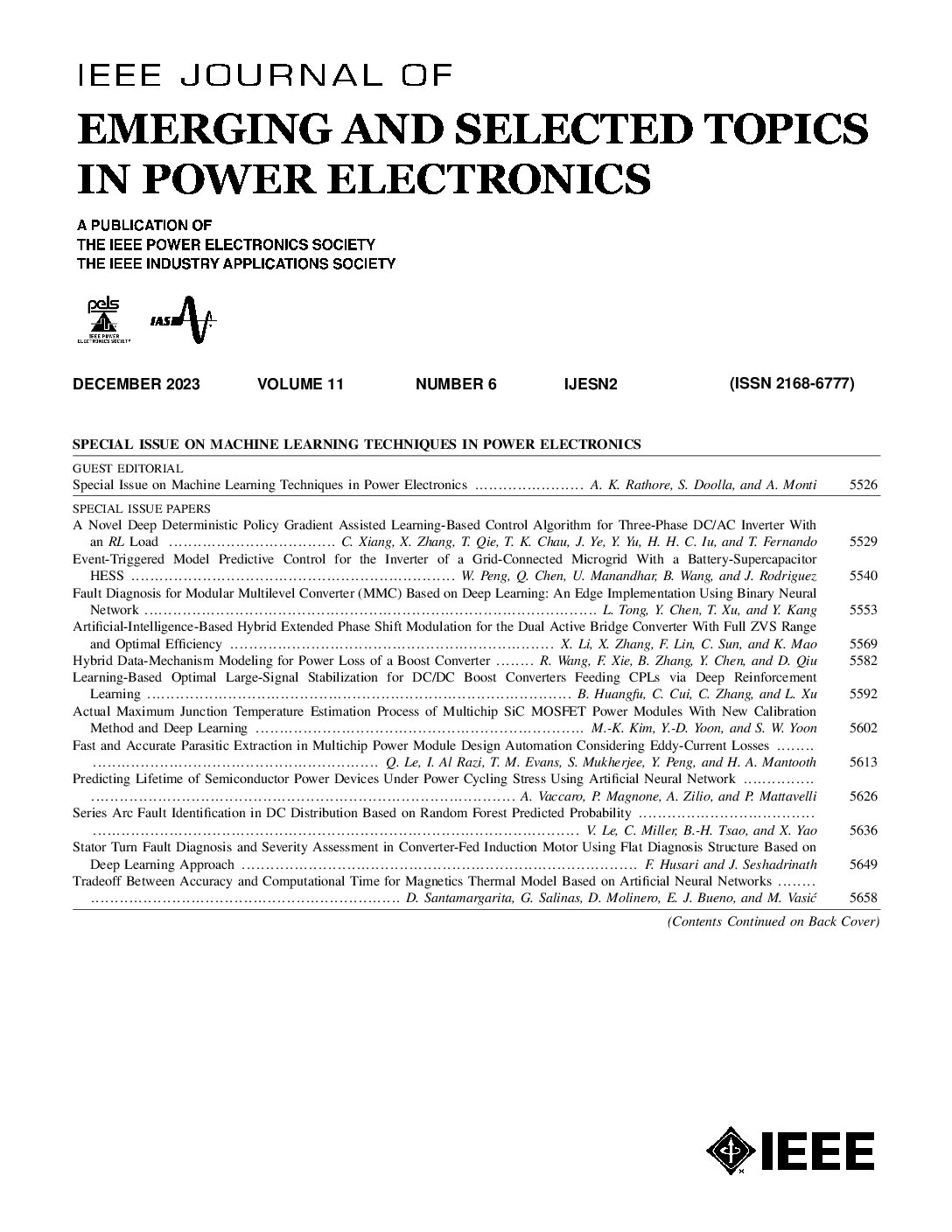利用改进的主侧控制策略增强分数阶自主无线电力传输系统的简化控制和误差容忍度
IF 4.9
2区 工程技术
Q1 ENGINEERING, ELECTRICAL & ELECTRONIC
IEEE Journal of Emerging and Selected Topics in Power Electronics
Pub Date : 2025-03-10
DOI:10.1109/JESTPE.2025.3549972
引用次数: 0
摘要
在无人机和自动导引车(agv)的无线充电应用中,需要无线功率传输(WPT)系统在主次侧偏移情况下实现稳定的功率输出。先前的研究表明,自主分数阶WPT (FOWPT)系统可以解决这个问题。然而,自主FOWPT系统面临着一定的挑战,如频率控制时临界耦合强度的限制,需要采样大而失真的线圈电压信号,以及在特定参数下输出功率与耦合强度并不完全独立。本文旨在分析自主FOWPT存在的问题,并通过推导建立输出功率与原系统参数之间的具体关系。通过将等效分数阶电容(FOC)的采样点和控制变量转移到逆变器,提出了一种增强的一次侧控制策略,通过控制逆变器输出有功功率恒定来保证线圈错位时输出功率的稳定。该策略无需进行FOC转换,即可达到与自主FOWPT相同的控制效果,简化了控制逻辑,降低了采样难度,提高了控制精度,扩大了系统的调节范围。仿真验证了所提控制策略的有效性,并比较了两种控制方法之间的区别和联系。106 W的样机测试结果表明,基于改进的控制策略,系统可以在0.14 ~ 0.6的动态耦合范围内保持稳定输出,功率波动范围仅为4.5%。本文章由计算机程序翻译,如有差异,请以英文原文为准。
Enhancing Simplified Control and Misalignment Tolerance in Autonomous Fractional-Order Wireless Power Transfer System With an Improved Primary-Side Control Strategy
In wireless charging applications for drones and automatic guided vehicles (AGVs), the wireless power transfer (WPT) system is required to achieve stable power output under primary- and secondary-side offset. Previous research has shown that an autonomous fractional-order WPT (FOWPT) system can address this issue. However, the autonomous FOWPT system faces certain challenges, such as limitations in critical coupling strength during frequency control, the need to sample large and distorted coil voltage signals, and the fact that output power is not entirely independent of the coupling strength under specific parameters. This article aims to analyze the existing issues in autonomous FOWPT and establish the specific relationship between output power and original system parameters through derivation. By shifting the sampling points and control variables from the equivalent fractional-order capacitor (FOC) to the inverter, an enhanced primary-side control strategy is proposed to ensure stable output power under coil misalignment by controlling the constant active power of the inverter output. This new strategy can achieve the same control effect as autonomous FOWPT without requiring FOC conversion, simplifying the control logic, reducing sampling difficulty, improving control accuracy, and expanding the system’s adjustment range. Simulations confirm the effectiveness of the proposed control strategy and compare the differences and connections between the two control methods. A prototype test generating 106 W shows that based on the improved control strategy, the system can maintain stable output within a dynamic coupling range of 0.14–0.6, with a power fluctuation range of only 4.5%.
求助全文
通过发布文献求助,成功后即可免费获取论文全文。
去求助
来源期刊

IEEE Journal of Emerging and Selected Topics in Power Electronics
ENGINEERING, ELECTRICAL & ELECTRONIC-
CiteScore
12.50
自引率
9.10%
发文量
547
审稿时长
3 months
期刊介绍:
The aim of the journal is to enable the power electronics community to address the emerging and selected topics in power electronics in an agile fashion. It is a forum where multidisciplinary and discriminating technologies and applications are discussed by and for both practitioners and researchers on timely topics in power electronics from components to systems.
 求助内容:
求助内容: 应助结果提醒方式:
应助结果提醒方式:


